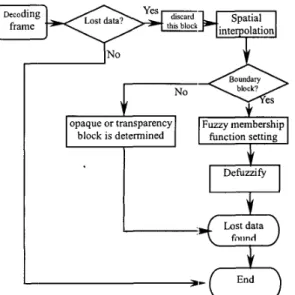WPM P-1.01
Robust Error Concealment Algorithm for MPEG-4 with the Aids of Fuzzy Theory
Pei-Jun Lee', Liang-Gee Chen', Wen-June Wang2, and Mei-Juan Che$
'Department of Electrical Eng., National Taiwan University, ,Department of Electrical Eng., National Central University, 3Department of Electrical Eng., National Dong-Hwa University,
Abstract
A new error concealment algorithm based on fuzzy set the-
ory is proposed to repair damaged portions of the shape in formation. By the experiment results, the proposed algo- rithm has better performance than previous works espe- cially on the case that the damaged portion includes the edge of object.
Introduction
In the last few years, more and more sophisticated digital video communication services and devices emerged in the market. Traditional video standard assumes that the com- pressed video bit-streams transmit in error-free medium. However, it is well known that the compressed video bit-streams are very sensitive to channel errors. MPEG-4 standard has not such limitation and it supports an ob- ject-based representation by allowing the coding of the shape information of arbitrarily shaped video objects along with the objects' texture and motion information. Therefore, the correctness of shape information is much more impor- tant than the other information.
When variable-length code (VLC) technique is used in the shape coding, variable-length characteristic inherently will makes VLC sensitive to noise errors. Even a single error in a video bit-stream may have a large influence on the video quality. Although previous works have shown that utilizing synchronization codeword or packet [ 11 can avoid error propagation. However, the efficient concealment algorithms
[ 2 ] of the shape information in the MPEG-4 are still impor-
tant
in
decoding work since they provide an acceptable ap- proximation of the original data.The algorithms
The spatial interpolation is the simplest error concealment method [3,4] under any cases such as I-frame, B-frame and P-frame. But there may be a problem happening when the interpolation is used in the alpha plane with boundary blocks. In other words, after interpolation the boundary blocks will produce a cloudy region, therefore the exact location of boundary is difficult to be identified. This paper uses a method based on fuzzy set theory to solve this prob- lem. In each row of a boundary block, we set a fuzzy set on the vague boundary interval. Then by the center of gravity
dehzzification technique, a value in the corresponding row is obtained to determine the boundary in the row. We take care every row of the boundary block by the same manner such that the boundary will be found. The procedure of OUI
algorithm is summarized in the following flow chart.
this block Decoding frame Defuzzify
cl
I->
(+)
Fig. 1 The system diagram of the proposed algorithm
In Fig. I , the formula for fuzzy membership is set
where
TI and T,
are some values from opaque and transparency, respectively,X i j
is the gray value of the pixel with coordinate( i , j )
in the block. Moreover, the formula for dehzzification is1
f ,( x s
) x q
where154
ky
is the dehzzified value.Results
Experimental results will demonstrate that the proposed algorithm improves significantly in terms of objective (shown in Table 1) and subjective (shown in Fig. 2) meas- urements compared with other methods. We can conclude that the proposed algorithm is more efficient and robust for recovering the lost data in the shape information.
Table. 1 Average PSNR and Pixel error comparisons for various schemes
Reference
]
Y.S Lee, W.S Chang, H.H No and C.Y Lee, “Construct of error resilient synchronization codeword for vari- able-length code in image transmission,” IEEE Znterna-tional Conference on Image Processing, 2000.
3
S. Shirani, B. Erol, and F. Kossentini, “A concealment method for shape information in MPEG-4 coded video sequences,” IEEE Tran. on Multimedia. V01.2, No.3, September 2000.] P.J. Lee and M.J. Chen, ”Robust recovery algorithm for video coding,” IEEE Trans. on Consumer Electronic,
.] M.J. Chen, L.G. Chen, and R.M. Weng, “Error conceal- ment of lost motion estimation vectors with overlapped motion compensation,” IEEE Trans. on Circuits and Systems f o r Video Technology, vo1.7,
No. 3 ,pp. 5 60-5 63, June 1 997.
V01.45, No.3, pp.851-859, August 1999.
Fig.2 Reconstructed pictures f o r Table Bream shape Se-
quence. ( I ) The original picture, (2) The damaged pic- ture, (3) The recovered picture by above motion vectol;
(4) The recovered picture by spatial interpolation threshold is 127, (5) The recovered picture by the pro- posed method.
